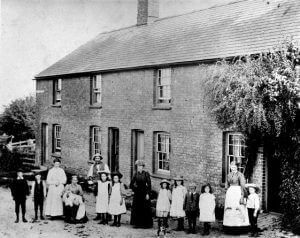Part 2: Memories of the Cottages, by Doug Tilbury
by Doug Tilbury

‘Photograph of about 1905 with, left to right, Arthur Tilbury, Reginald Tilbury, Mrs Owen Smith, Mrs A Smith (with her pillow lace), Eldred Tilbury, Dorothy Tilbury, Alice Tilbury, Mary Tilbury, Daisy Smith, Florence Smith, William Beverage and sister Ciss Beverage ( Dr Barnado’s children, fostered by cottagers), Mrs G Saunders, Archibald Tilbury who lived at Lilly Bottom Farm’
Life in the Cottages
There were stone sinks, quite shallow, on two brick pillars. Underneath the sink was a bucket of water taken from a rainwater tank in the ground. This collected water drained from the roof. The bucket was lowered by a long pole with a hook. Water was also obtained from local ponds. There were a number of these in the Hampden Woods.
The table was of scrubbed wood, with a drawer for cutlery and Windsor chairs around it.
In the corner of an outhouse would be a copper. The washing was passed through a mangle, and on wet days, wet washing would hang everywhere around the cottage. The copper was also used to boil puddings, such as the local favourite, bacon badger.
Large boilers were also needed to make wine. Dandelion wine was a favourite. The landlords in small pubs did their own brewing, although they did not always get it right.
Cooking was done on a black leaded kitchen range, which supplied the only heating in the home. It also heated the flat irons used for ironing.
The winters were hard, and you could always see “Jack Frost” on the window panes.
We had feather beds with two thick woollen blankets and a duck feather eiderdown. Most cottages had only two bedrooms, and the children slept head to tail. When we took in three girl evacuees, there were six of us in our small bedroom.
Although we didn’t have much, Father Christmas did call. We usually got a stocking with an orange, a piece of coal and a small present or 10 shilling note. One very memorable Christmas, I received a tricycle!
Over the fire, there was a mantelpiece with a clock and a few ornaments. Beside the fire was a trivet for boiling a kettle and a toasting fork.
Pigs were killed twice a year, March and November. The meat was rubbed with salt to preserve it and made into bacon. Then it was hung in a corner by the fireplace. Fresh pork was also eaten. Everything was used except the bladder (which was blown up to make a football), and the tail. Chitterlings and trotters were a great delicacy. Backbone pie was also a favourite. Meat from the head was used to make brawn, and the cheeks were called “bath chops”.